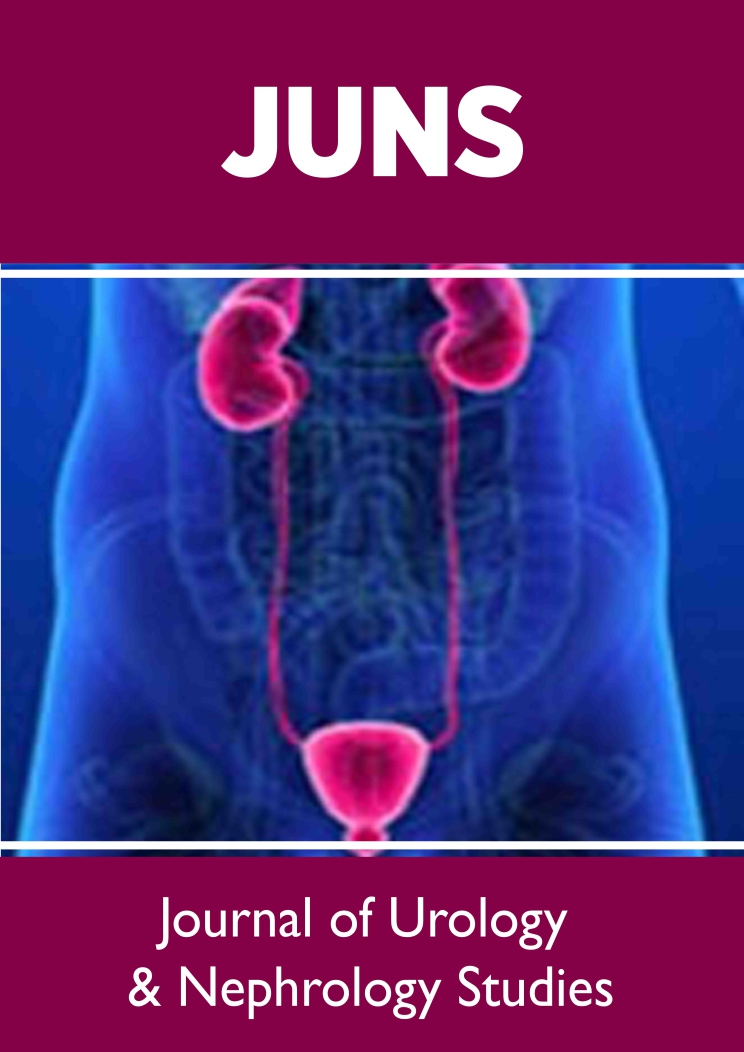
Lupine Publishers Group
Lupine Publishers
Menu
ISSN: 2641-1687
Mini Review(ISSN: 2641-1687) 
On the Question of Neuroleptic Amyloidosis Volume 2 - Issue 3
Volkov VP*
- Tver center of judicial examinations, Russia
Received: September 26, 2019; Published: October 09, 2019
Corresponding author: Volkov VP, Tver center of judicial examinations, Russia
DOI: 10.32474/JUNS.2019.02.000136
Abstract
The article describes the observations of renal amyloidosis, developed in the course of long-term antipsychotic therapy of patients with schizophrenia, which can be considered as one of the variants of neuroleptic disease, this severe iatrogenic multiple organ pathology, due to a wide range of the negative side effects of antipsychotic drugs.
Keywords: Antipsychotic drugs; side effect; kidney amyloidosis
Introduction
The problem of amyloidosis is one of the urgent problems in
biology and medicine (1-3). Modern ideas about amyloid genesis
suggest the production of a special amyloid precursor protein under
the influence of the so-called amyloid-releasing factor produced by
macrophages due to a genetic defect or under the influence of a
stimulating agent (4). It is believed that various defects in the body’s
immune system lead to the formation of amyloidosis (5). However,
it has long been known that many antipsychotic drugs (AP) have
a certain immunotropic activity, changing the permeability of cell
membranes, including immunocompetent cells (6). In this regard,
the data on a statistically significant increase in the frequency of
brain amyloidosis in patients with schizophrenia are noteworthy
(7). These facts in relation to the problem of amyloidogenesis are
of particular interest. It is believed (8) that the pathogenesis of
cerebral amyloidosis is close to that of AA-amyloidosis, the main
target organ of which is the kidneys (nephropathic amyloidosis)
(1,2). One of the main links of AA-amyloidogenesis is the active
participation of monocytic phagocyte elements in the process
(2,3,9). In particular, phagocyte cytomembrane enzymes play an
essential role (2,10). A certain correlation between the content
of serum amyloid protein in the blood and the state of monocytic
phagocyte and lymphocyte systems was also established (2,9).
Thus, AP, affecting the immune system, by their pharmacological
and biological properties may well be amyloidogenic agents (11).
However, amyloidosis, etiologically caused by the use of drugs,
including AP, is practically not described. In this regard, the data
analysis of the observations neuroleptic amyloidosis of the kidneys,
the main criteria for diagnosis was:
a) prolonged antipsychotic therapy (APT) primary mental
illness
b) absence of somatic pathology, complication which could
be amyloidosis
c) morphological and histochemical properties of amyloid,
characteristic of secondary AA-amyloidosis.
Material and methods
The case histories and autopsy materials of patients with schizophrenia who died in the Tver regional M. P. Litvinov’s psychiatric hospital № 1 from 1952 to 2011, in which an autopsy was found amyloidosis of the kidneys. According to the given diagnostic criteria, 12 observations were identified. Archival micropreparations after appropriate treatment were again stained with an alkaline solution of congo red and studied in polarized light. The autoclave method proposed by T. Kitamoto and co-authors (1986) (12) was used to verify AA-amyloidosis.
Results
Of the 12 deaths, there were 6 men and 6 women aged 19 to 67 years. The median age was 42 years for males and 53 years for females. The period from the beginning of APT to the appearance of persistent urinary syndrome is from 40 to 296 months, on average, about 15 years. In all cases, there was a fairly typical clinic for the development of nephropathic amyloidosis. Manifestation of the disease in 11 patients began with isolated urinary syndrome. Only 1 patient aged 49 years immediately developed a complete nephrotic syndrome with a rapid increase in edema. However, 7 of the 11 mentioned patients subsequently also developed complete (edematous) nephrotic syndrome. Term of occurrence of edema after detection of persistent changes in urine from 4 to 8 years. In 3 patients, edema was initially transient and only eventually became permanent. Blood pressure in 11 patients was constantly within the normal range or even slightly lowered. Only 1 examined person had hypertension with figures 160/110-190/100 mm Hg 2 months before death. Persistent proteinuria was observed in all patients, but its level was different. In 1 patient, the protein content in the urine was only 0.033‰, in 3 it did not exceed 0.33‰, in 2-1,65‰. Most often, the maximum level of proteinuria was kept within 3.3‰ (4 patients), sometimes reaching 6.6‰ (2 patients). Daily protein loss was determined only in 2 people. It was 2.4g and 3.3g.
A constant phenomenon was a small persistent leukocyturia. The number of leukocytes in the field of vision ranged from 1-2 to 6-8. Hematuria was observed in 8 patients, was unstable and very moderate (the number of red blood cells from a single to 2-4 in the field of view). Transient small cylindruria was observed in 9 patients. Cylinders were, as a rule, hyaline and granular, occasionally waxy, their number in the field was of view to 2-3, sometimes 5-6. The described features of urinary sediment are considered typical for urinary syndrome in renal amyloidosis (13,14). In clinical blood tests in all patients revealed moderate hypochromic anemia. Attention is drawn from the very beginning of treatment with AP constantly accelerated ESR (on average, up to 25mm/h), which indirectly indicates certain shifts in homeostasis. Moreover, in recent years of the disease in the presence of persistent urinary syndrome (ie, essentially, kidney amyloidosis), the average value of ESR was about 45mm/h. A similar phenomenon in renal amyloidosis is known from the literature (3,13).
Changes in blood biochemical parameters are essential and typical for nephrotic syndrome. Thus, hypercholesterolemia was recorded in 7 out of 10 examined patients. The maximum cholesterol level was 17.2mmol/l, the average value of 8.58mmol/l. Fibrinogen blood was determined in 5 patients and in all cases was increased. Its average level is 6.58g/l with fluctuations from 4.44 to 9.32g/l. Seriously disturbed protein metabolism. Studies were conducted in 6 patients. All of them show pronounced hypoproteinemia. By the time of death, the total protein content in the blood fell to 38g/l in 1 patient, to 40-44g/l in 4 patients and only 1 was only slightly below normal (62.7g/l). At the same time, all the examined patients had significant dysproteinemia. Thus, the average content of albumins was 39%, globulins-61%. A/G coefficient is significantly reduced (average-0.7). The study of globulin fractions showed a relatively normal content of alpha-globulins and the rise of betaand especially gamma-fractions. The averages are 17.5%, 14.8% and 23.9%, respectively.
Nitrogen-excreting renal function persisted for a long time. The level of residual nitrogen, urea and creatinine in almost all patients remained within the normal range. Only 4 patients in the last month before death slightly increased blood levels of urea and creatinine (to8.5-15.8 mmol/l and 125-135 mmol/l, respectively). However, the Rehberg test conducted in 2 patients showed a decrease in glomerular filtration (up to 60.2 and 75ml/min) and tubular reabsorption (up to 85-86%).
Ultrasound examination of the kidneys was performed in 4 patients and 3 of them repeatedly. Diffuse changes in renal parenchyma were noted in all findings. The patients died from various causes. In proteinuric stage of renal amyloidosis died 5 patients, in nephrotic one-6; in 1 patient was observed a transition in nitrogenemiс stage. During the period of the developed nephrotic syndrome all six patients died from the increasing heart failure. A similar mechanism of death in renal amyloidosis is well known (3,14). Two died from acute pneumonia and coronary pathology, one from hemorrhagic stroke and drug toxicoderma, which is described in the literature as a result of side effects of chlorpromazine (15). The section revealed a typical pattern of renal amyloidosis. In 10 deceased patients it was the so-called big greasy buds, their weight ranged from 480 to 960 g. In 2 cases the kidneys were amyloid wrinkled (weight 300 and 340g). In 3 cases, in addition to the kidneys, the spleen was affected by amyloidosis, and in 1 of them the liver was also affected. Microscopically, congophilic amyloid masses were found in the capillary loops of the glomeruli and in the vessel wall. The intensity of amyloid deposition in glomeruli ranged from focal to total lesion. In this case, the severity and prevalence of the process correlated with clinical stages, as well as with the duration of APT. Thus, with a period of treatment of more than 15 years, total defeat of the vast majority of glomeruli was revealed in all cases, and with a period of less than 15 years only in 2 of 6 ones. In polarized light, the characteristic dichroism of amyloid was detected in the form of a light greenish glow. During denaturation of amyloid by means of temperature action (autoclaving of sections before painting the congo red at a temperature of 130°C) according of the method of T. Kitamoto and co-authors (1986) (12) its tinctorial properties were lost within 30 minutes, which is inherent in AA-type amyloid (12, 16).
Discussion
Thus, in the described observations after prolonged APT a fairly typical clinic for the development of nephropathic amyloidosis was noted. As a rule, it manifested as an isolated urinary syndrome, which subsequently turned into a complete nephrotic syndrome with edema, increasing hypo- and dysproteinemia, hypercholesterolemia and hyperfibrinogenemia in more than half of patients. In this case, there was usually no hypertension and severe azotemia. Morphologically, the process in the kidneys was verified as secondary nephropathic AA-amyloidosis. In our opinion, neuroleptic amyloidosis is a form of neuroleptic disease, caused a wide range of the negative side effects of AP and including such pathology as neuroleptic cardiomyopathy, sudden cardiac death, neuroleptic malignant syndrome, neurological extrapyramidal disorders, metabolic syndrome, endocrine dysfunction, toxicodermia, disorders of leukopoiesis, cholestatic hepatitis, etc (17).
Conclusion
So, the described cases of renal amyloidosis, developed in the process of APT, show the possibility of developing this pathology as a result of long-term administration of AP. This kidney damage is quite logical to consider one of the manifestations of the so-called neuroleptic disease. The appearance of clinical and laboratory signs of renal pathology in patients receiving long-term AP, should alert physicians in terms of the development of neuroleptic amyloidosis.
References
- Kozlovskaya LV, Chegaeva TV, Rameev VV (2000) New in the classification, diagnosis and treatment of amyloidosis. Ros med zhurn 8(2): 46-50.
- Serov VV (1989) Amyloidosis: new facts, controversial and unresolved issues. Arhpatologii 51(10): 3-10.
- Serov VV, SHamov IA. Amyloidosis(1977) Medicine Publishers, Moscow, Russia.
- Immunology of amyloidosis.
- Kuznecova NI, Konstantinova TP(1978) Some indicators of natural immunity in individuals with different duration of treatment with phenothiazines. SovMedicina41(7): 45-9.
- Ojfa AI(1987) Senile cerebral amyloidosis. Medicine Publishers, Moscow. Russia.
- Serov VV (1998) Senile amyloidosis: from the Schwartz’s triad to the present day. Arh patologii 60(1): 23-27.
- Kochubej LN, Vinogradova OM, Serov VV et al. (1988) AL- and AA-amyloidosis (state of the problem). Klin. Medicina 66(8): 7-16.
- Fuks A, ZuckerFranklin D (1985) Impaired Kupffer cell function precedes development of secondary amyloidosis. J Exp Med 161(5): 1013-1028.
- Volkov VP (2005) Drug amyloidosis: myth or reality? Verhnevolzhskij med zhurn 4(5-6): 33-37.
- Kitamoto T, Tashima T, Tateishi J (1986) Novel histochemical approaches to the prealbumin-related senile and familial forms of systemic amyloidosis. Am J Pathol 123(3):407-412.
- Mazhdrakov G (1976) Amyloidosis of the kidney. In: Mazhdrakov G, Popov N(eds.). Kidney Disease. Sofiya: MedicinaifizkulturaPubl, 648-659.
- SHulutko BI (1983) Renal Pathology. Clinical and morphological study. Medicina Publishers, Leningrad, Russia.
- VolkovVP (2010) Skin complications of phenothiazine therapy (review of literature). Psihiatr psihofarmakoter 12(3): 33-37.
- Zykova LD(1989) Methods of verification of forms of amyloidosis by pathologist. Arhpatologii 51(1): 63-64.
- Volkov VP (2012) To the question of neuroleptic disease. Nauchnaya diskussiya: voprosy mediciny: III mezhdunarodnaya zaochnaya nauchno-prakticheskaya konferenciya. Moscow, Russia, pp. 83-99.

Top Editors
-

Mark E Smith
Bio chemistry
University of Texas Medical Branch, USA -

Lawrence A Presley
Department of Criminal Justice
Liberty University, USA -

Thomas W Miller
Department of Psychiatry
University of Kentucky, USA -

Gjumrakch Aliev
Department of Medicine
Gally International Biomedical Research & Consulting LLC, USA -

Christopher Bryant
Department of Urbanisation and Agricultural
Montreal university, USA -

Robert William Frare
Oral & Maxillofacial Pathology
New York University, USA -

Rudolph Modesto Navari
Gastroenterology and Hepatology
University of Alabama, UK -

Andrew Hague
Department of Medicine
Universities of Bradford, UK -

George Gregory Buttigieg
Maltese College of Obstetrics and Gynaecology, Europe -

Chen-Hsiung Yeh
Oncology
Circulogene Theranostics, England -
.png)
Emilio Bucio-Carrillo
Radiation Chemistry
National University of Mexico, USA -
.jpg)
Casey J Grenier
Analytical Chemistry
Wentworth Institute of Technology, USA -
Hany Atalah
Minimally Invasive Surgery
Mercer University school of Medicine, USA -

Abu-Hussein Muhamad
Pediatric Dentistry
University of Athens , Greece

The annual scholar awards from Lupine Publishers honor a selected number Read More...




